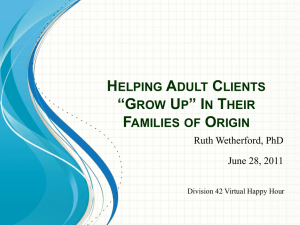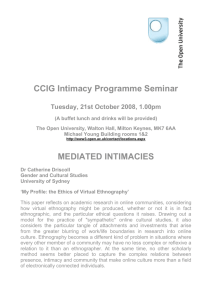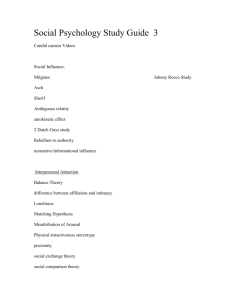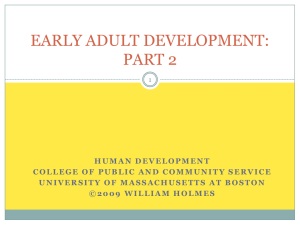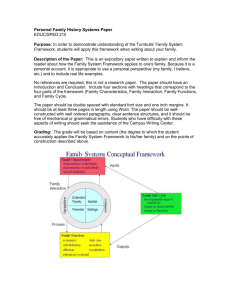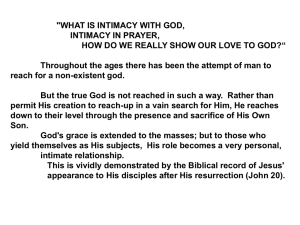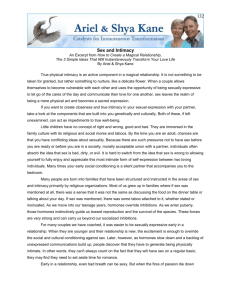Intimacy in a Three-Piece Suit - Dialogue: A Journal of Mormon
advertisement
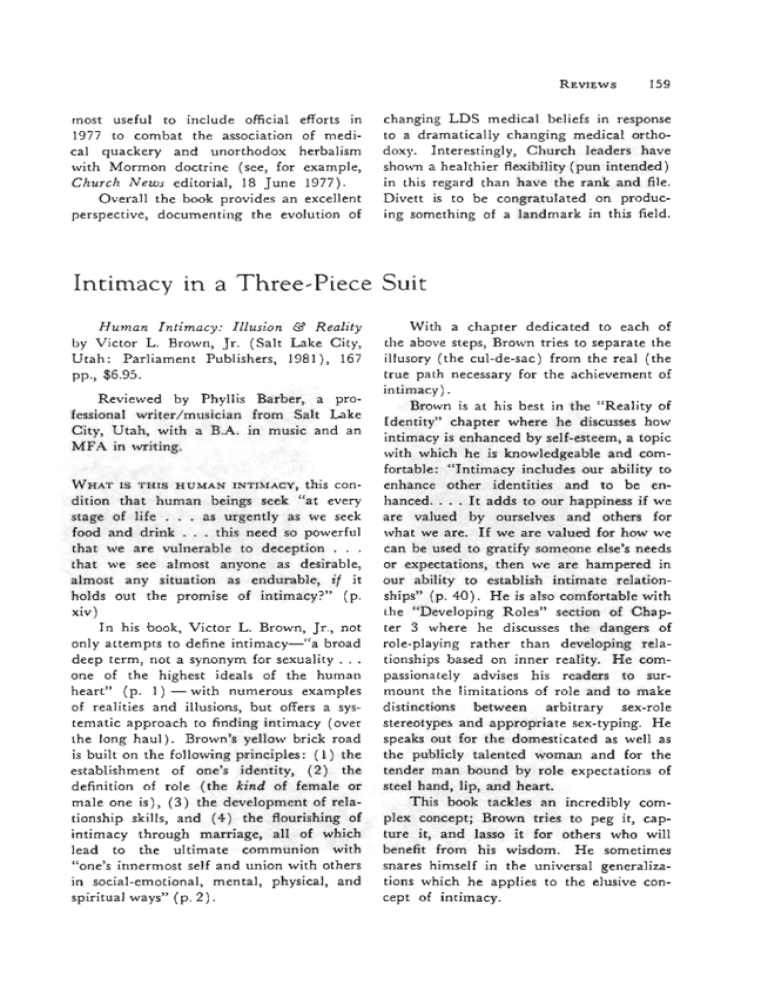
REVIEWS most useful to include official efforts in 1977 to combat the association of medical quackery and unorthodox herbalism with Mormon doctrine (see, for example, Church News editorial, 18 June 1977). Overall the book provides an excellent perspective, documenting the evolution of 159 changing LDS medical beliefs in response to a dramatically changing medical orthodoxy. Interestingly, Church leaders have shown a healthier flexibility (pun intended) in this regard than have the rank and file. Divett is to be congratulated on producing something of a landmark in this field. Intimacy in a Three-Piece Suit Human Intimacy: Illusion & Reality by Victor L. Brown, Jr. (Salt Lake City, Utah: Parliament Publishers, 1981), 167 pp., $6.95. Reviewed by Phyllis Barber, a professional writer/musician from Salt Lake City, Utah, with a B.A. in music and an MFA in writing. WHAT IS THIS HUMAN INTIMACY, this con- dition that human beings seek "at every stage of life . . . as urgently as we seek food and drink . . . this need so powerful that we are vulnerable to deception . . . that we see almost anyone as desirable, almost any situation as endurable, if it holds out the promise of intimacy?" (p. xiv) In his book, Victor L. Brown, Jr., not only attempts to define intimacy—"a broad deep term, not a synonym for sexuality . . . one of the highest ideals of the human heart" (p. 1)—with numerous examples of realities and illusions, but offers a systematic approach to finding intimacy (over the long haul). Brown's yellow brick road is built on the following principles: (1) the establishment of one's identity, (2) the definition of role (the kind of female or male one is), (3) the development of relationship skills, and (4) the flourishing of intimacy through marriage, all of which lead to the ultimate communion with "one's innermost self and union with others in social-emotional, mental, physical, and spiritual ways" (p. 2). With a chapter dedicated to each of the above steps, Brown tries to separate the illusory (the cul-de-sac) from the real (the true path necessary for the achievement of intimacy). Brown is at his best in the "Reality of Identity" chapter where he discusses how intimacy is enhanced by self-esteem, a topic with which he is knowledgeable and comfortable: "Intimacy includes our ability to enhance other identities and to be enhanced. . . . It adds to our happiness if we are valued by ourselves and others for what we are. If we are valued for how we can be used to gratify someone else's needs or expectations, then we are hampered in our ability to establish intimate relationships" (p. 40). He is also comfortable with the "Developing Roles" section of Chapter 3 where he discusses the dangers of role-playing rather than developing relationships based on inner reality. He compassionately advises his readers to surmount the limitations of role and to make distinctions between arbitrary sex-role stereotypes and appropriate sex-typing. He speaks out for the domesticated as well as the publicly talented woman and for the tender man bound by role expectations of steel hand, lip, and heart. This book tackles an incredibly complex concept; Brown tries to peg it, capture it, and lasso it for others who will benefit from his wisdom. He sometimes snares himself in the universal generalizations which he applies to the elusive concept of intimacy. 160 DIALOGUE: A JOURNAL OF MORMON THOUGHT Brown gets in his own way, for instance, when he resorts to moralistic preaching: calling unwed parents "sad people" (p. 118), saying that people dismiss moral values because "they don't like them," calling those dismissals "intellectual temper tantrums" (p. 118), and assigning loud voices to proponents of irresponsible and exploitive sex while those who prefer fidelity have "much quieter voices" (p. 119). Sometimes he defers to simplistic reasoning by over-using such homilies as "the lowest common denominator" or loses sight of the validity of his position and employs defensive posturing as in his case for the homemaker wife whom he considers to have been slandered by contemporary society's "arrogant nonsense" (p. 109). The generalized polarities he sets up on page after page — indulgence vs. discipline, sex drive vs. voluntary sexual behavior, integrity vs. lust, sexual exploitation vs. relationship skills — are problematical. Not only are some not even logical opposites, but he decries polarities himself when he discusses the choice between marriagechildren and community-career: "An eitheror ultimatum betrays its weakness, especially since adherents to one extreme are likely to deny any fulfillment at all in the other position" (p. 93). The basis of the book, the comparison of reality and illusion, also has inherent difficulties. Brown sets the two in opposition by defining reality as "the process of identifying consequences" and illusion as "the process of ignoring consequences." He also seems to believe that his suggested path always or nearly always results in happiness and that other alternatives do not. Neither reality nor illusion can be packaged so neatly. For example, we often don't know what the consequences of any given action will be. Every situation is unique, and every action has both costs and benefits. And when Brown says that "most human misery can be prevented by wise and disciplined living" (p. 3), he forgets Job, the Poles and Jews in World War II, and the innocents of every age who suffer death and pain along with the guilty. No one can be shielded from human suffering. Are the "safe paths" always reality or are they sometimes also an illusion? And are the risky paths always illusion or are they sometimes reality? Is it always true that every sexual relationship outside of marriage has resulted in more pain and sorrow than in benefits received or growth experienced? Brown's main contribution is his addressing the issue of how we can achieve human intimacy, draw closer to each other, and alleviate a portion of human suffering. He is concerned and compassionate. He should be applauded for wrestling with the ever-complicated issues of sex, love, and intimacy. He admits that his recommended path is not easy, that there are problems (though not insoluble in most cases), and that the effort to achieve intimacy will prove rewarding if people will be patient, longsuffering, and follow some common sense, time-proven rules. "Those looking fr easy recipes for intimacy will be disappointed" (p. xv). He does, however, work within a particular point of view and is sometimes inhibited by this posture. While the book attempts to touch lives, it remains slightly detached from the flux of humanity. Brown's approach to intimacy seems packaged in a three-piece, pin-striped suit. Refreshingly, he acknowledges that intimacy does include the physical: "Ignorance about our bodies, our minds, and the consequences of sexual expression may be the greatest enemy of sexual intimacy" (p. 112). But the book's message about the body's role in intimacy seems confused and mixed. Brown relegates the body to a bottom rung in the search for intimacy, an inferior member of the mind/spirit/body triumvirate: "In human relationships, the heart and mind do, in fact, rule. . . . To seek in biology the key to understanding relationships is to seek in vain" (p. 78). Granted that biology is not the only avenue to intimacy, Brown's discussion of sexuality is often preceded by words such as "exploitive" or "lustful." When he
